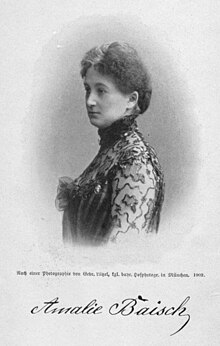Amalie Baisch
Amalie Baisch (born Amalie Marggraff) | |
|---|---|
 Photo of Baisch from 1890 | |
| Born | 8 October 1859 Munich |
| Died | after 1904 |
| Occupation | Writer |
| Nationality | German |
Amalie Baisch(néeMarggraff;8 October 1859 inMunich– after 1904) was a German writer, best known for herVictorian eraguide bookson young women'setiquette.She wrote under the pseudonymErnesta.[1][2][3][4]
Life[edit]
Amalie Baisch was born inMunich,Kingdom of Bavaria,on 8 October 1859. Her father wasRudolf Marggraff,a professor of Art History and Fine Art at theAcademy of Fine Arts, Munich.Her mother was called Elisabeth Marggraff. Amalie Basch attended theGymnasium Max-Josef-Stiftand subsequently took a job as a teacher in Paris. She was a guest in the Parisian salons and travelled extensively. She documented her experiences in a series of literary sketches.
In 1885, Baisch married the authorOtto Baisch(1840–1892). Otto had known Rudolf Marggraff since the 1870s. Before his death, Marggraff had been working on a biography ofJohann Christian Reinhart,which Otto completed as published in 1882 under the titleJohann Christian Reinhart und seine Kreise.
One year before their marriage, Otto took up the position of editor-in-chief of the illustrated magazineÜber Land und Meerin Stuttgart, and thus the pair relocated there. Amalie found a stimulating cultural atmosphere in Stuttgart. In 1886, Baisch gave birth to a son, Hermann Baisch.
From 1886 the family lived in a rented flat at 123 Neckarstraße, in the building of theDeutsche Verlags-Anstalt,the publishers ofÜber Land und Meer.After the death of Otto Baisch in 1892, Amalie and her son moved to 31 Kernerstraße for a year, before moving back to Munich, were they lived in 14 Barerstraße. Amalie Baisch later remarried to a Major Florian Gassner.
Work[edit]
Amalie Baisch's books had a target audience of young women and were predominantly advice books. Below is a selection of her works:
- Aus der Töchterschule ins Leben. Ein allseitiger Berater für Deutschlands Jungfrauen,1889
- Die kleiner Feuerwehr,1892
- Der Mutter Tagebuch. Aufzeichnungen über die ersten Lebensjahre ihres Kindes,1893
- Das junge Mädchen auf eigenen Füßen. Ein Führer durch das weibliche Berufsleben,1902
- Hilde Stirner. Eine Jungmädchenerzählung,1909
References[edit]
- ^Friedrichs, Elisabeth (1981).Die deutschsprachigen Schriftstellerinnen des 18. und 19. Jahrhunderts: ein Lexikon.Stuttgart: Metzler. p. 13.ISBN3-476-00456-2.
- ^Lexikoneintrag zu der Schriftstellerin Frau Amalie Baisch. Pataky, Sophie: Lexikon deutscher Frauen...(in German). p. 32.
- ^Lexikoneintrag zu der Schriftstellerin Elisabeth Marggraff. Pataky, Sophie: Lexikon deutscher...(in German). p. 15.
- ^Krämer, Stefanie (2004).Mädchenliteratur im Wilhelminischen Kaiserreich und ihre pädagogischen Implikationen(in German). Hamburg: Diplom.de. pp. 79–82.
